Flying 4,000 miles to look at some new technology would, for many, be considered madness – but for me, it’s a job. And when you get there and find a wealth of new things to look at, it makes all those hours sat in economy, next to the rather grumpy Dutch lady with personal space issues, all the more worthwhile. While Autodesk’s Mechanical development is split across almost every region of the globe, Portland is the management hub and the key decisions and movements are made from here.
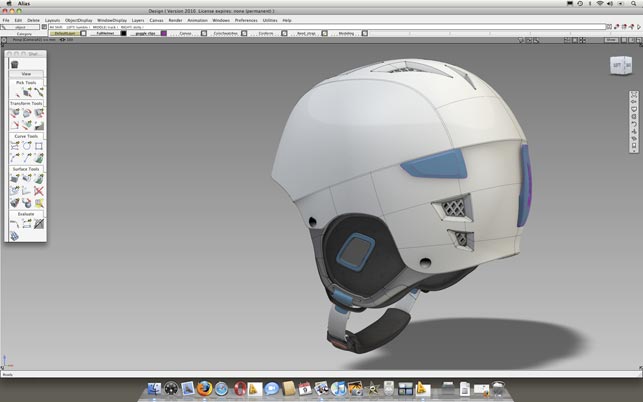
Alias, running natively, on Mac OS X
The Manufacturing group’s remit and product line has expanded hugely in the last three or four years: from the days of AutoCAD Mechanical and Mechanical Desktop, through to Inventor and now has a range of analysis and manufacturing products. While the core is Inventor, this product has been expanded by acquisition from a 3D modelling and draughting system, to an integrated design and analysis platform.
The acquisition of Alias gave Autodesk a massive shot of adrenaline, both in terms of the types of customers it was talking to (particularly automotive), as well as providing a raft of technology that few would ever have a hope of replicating. Alongside the pretty much unparalleled surface modelling tools for both the industrial design and automotive worlds, Alias brought Showcase and SketchBook to the company – two applications which are now gaining more exposure than they ever could have under Alias alone.
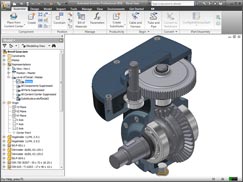
Inventor 2010 introduces the Ribbon-based UI that’s been developed in consultation with users on Autodesk Labs website
So, with all this acquisition and development work going on, what does the 2010 release look like?
Most integrated Inventor yet
First off, Inventor 2010 looks incredible. The first thing you’ll notice is that the ribbon interface has been adopted across the entire Inventor suite of products. Now, while I’ve railed against this in other forms, when it’s done right, it works and works well. What’s interesting here is that alongside all of the acquired technologies, Autodesk has also been actually using its Labs website in earnest. While many other vendors maintain a Labs website, where ‘in late development’ code is put out for public consumption and comment, Autodesk is engaging its user community at a much earlier stage. In the last year or so we have seen the next Inventor UI be put through its paces on labs, along with many other tools which we’ll get to shortly. This means that the final shipped version has had all the rough spots knocked off, with users feeding back what’s good and bad, and it shows.
The categorisation of the commands (into discreet areas, such as design, assemble, inspect) is intuitive and is arranged sensibly. But what’s intriguing is how the new tools have been given the same reorganisation. A perfect example is the changes made in stress analysis.

Assembly motion simulation uses physical simulation to find out how parts and drives interact. This information can then be used to feed further Finite Element Analysis
Stress analysis
The Ansys-based, parts only limitation of previous versions has been dumped and you’ll now find the Finite Element Analysis (FEA) technology from Plassotech has been introduced to the core Inventor product, enabling full assembly analysis. This can be driven from manual inputs, but a more intelligent way is to use the assembly simulation tools. These can be used to work out how loads transfer between components in motion and with respect to time, and then that data can be used to find maximum loading conditions and transfer all of the forces and loading data to Stress Analysis. Again, this is fully integrated into the same workflow, as the data is fully transportable (with contacts auto-created where possible).
It’s obvious that a lot of work has been done on these tools, and one thing particularly worth highlighting is the breadth of optimisation tools now available. While most FEA systems include some form of optimisation, Inventor now allows you to conduct design experiments where you can define goals, parameters and variables for optimisation, then use various techniques to find a smaller set of studies that will get you as close to your goals as possible. It’s quick to find the variables that have the greatest effect and influence on the performance of the design, enabling you to narrow down your geometry and get closer to the optimal in a shorter space of time.
Plastic fantastic
Another key focus for this release is the design and manufacture of plastic parts, specifically, injection moulded parts. Development work has been split into two fronts – plastic parts and mould design.
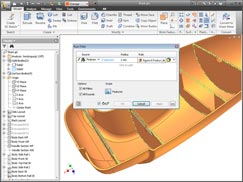
New plastic part design features mix a range of intelligent tools, with new technology focussed on maintaining shells and wall thickness
Autodesk Labs has had the plastic part design technology preview for some time. This is based on a development done at Autodesk by Attilio Rimoldi (founder of ImpactXoft) to offer an intelligent method of creating plastic parts. This intelligence is not only in terms of how a history-based system handles and maintains a constant wall thickness, but also in terms of adding an impressive range of plastic part features (such as mounting bosses, grills, ribs, lips/grooves etc) that support the industry’s language and geometry types, as well as some standard features that might prove mighty difficult to model manually.
Alongside the core design tools, 2010 sees the long awaited release of Inventor’s mould design tools. Autodesk has been developing these tools for a couple of years now extensively testing the code via beta testers in China and Brazil. After all, if you’re going to have a mould design tool tested to destruction, then where better than the world’s tooling hot houses? From what I saw the toolset looks really quite well developed and we’ll be covering it in-depth in a forthcoming issue, but all of the usual suspects are there, from split line and shut-off creation, to core and cavity splitting, and into the realms of mould base design, ejector and gating location, slides, lifters and cooling channels.
The toolset looks very interesting, giving a range of process-driven tools that combine a workflow with the ability to dive in and work manually (something that’s essential). If there’s one thing that’s screamingly obvious in its absence, it would be electrode design, or at least the ability to extract spark forms and create surface shut-offs in their place, so you have a truly complete core/cavity. That aside, it’s a well rounded offering for a first general release.
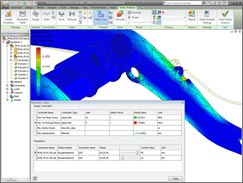
Design of experiment and parametric studies are possible within stress analysis, allowing users to define goals and parameters, then find the key influences on a product’s performance
Alias and Inventor integration
The Alias acquisition gave Autodesk a boost and a fresh perspective on the industries it has traditionally served. Alias has always been primarily aimed at Industrial Design and Automotive Design. Its interface doesn’t look like any other 3D design system and from that, you can learn a great deal. Alias grew out of various organisations and platforms (the SGI ownership still leaves its mark on the user interface to this day), but what it lacks in Windows-standardisation, it more than makes up for in sheer capability and tuning for a very specific workflow.
What’s interesting is that the development team has been consistently improving its usability and while it may look odd to those schooled in Windows, it’s unparalleled in its ability to create and manipulate surface geometry.
The 2010 release sees the UI work continue to strip back the toolbars (referred to as Shelves) and dialogs, add in helpers like the ViewCube (that’s common across all Autodesk products these days) and to generally provide a much greater level of direct geometry manipulation and feedback. There’s also been some repackaging of the various forms of Alias and you’ll now find three core offerings: AliasDesign, Alias Surface and Alias Automotive.
AliasDesign provides NURBS-based modelling, digital sketching and all the basics you’ll need to get working on for any concept design. Alias Surface builds on this, adding greater surface control, a mix of both NURBS and Bezier surfacing technology, reverse engineering (in terms of point cloud and poly-mesh handling) and realtime visualisation. At the top end of the tree is Alias Automotive, which has the ultimate in surface control and fine-tuning for those looking for complexity and utter perfection.
While there are numerous updates to the core capability in the system, one of the big things for the 2010 release cycle is the massively improved associativity between Alias and Inventor. While the last couple of releases saw some basic interoperability, 2010 looks to reset the benchmark for how these things should work. Essentially, links between these two, quite different, systems have been made much more intelligent and full. Changes can be propagated and fed through the process in the manner that you require.
Conclusion
I’ve barely scratched the surface of what I saw in Portland, so I’ll be looking at each product in its own right over the coming months, starting with Inventor next issue.
While I came away from the event with a head-full of information, perhaps the lasting impression I had was one of a company that has acquired a huge amount of technology in recent years and has obviously been executing to a very big plan. The integration of in-house developed tools with acquired technology (from the likes of Plassotech and Moldflow which I’ve not even mentioned) is breathtaking. Inventor looks incredible for the 2010 release cycle and should set the groundwork for a good few years of work to come.
The thing that really struck me was how well integrated the Inventor Suite is and much of that comes down to a switch in UI design for this release. When you’re trying build new tech into an existing system, it’s always a struggle to fit it in properly. By switching to the ribbon while building in all of these tools for plastic part design, tooling, analysis and simulation, Autodesk has given Inventor an incredibly well thought-out interface that supports a much wider remit than it has ever done. It’s truly elegant to see it in action.
Alias remains the different looking system out of the offering – and it probably will continue to be for quite some time. The Alias users have a very different set of requirements in terms of workflow and functionality. Yes, changes can be made to make it more interactive and more dynamic, but the system remains usable and ultimately very powerful. It’ll never be shoe-horned into Inventor, because the workflows are so different, but the development done to make the two systems work together should see it gain more traction outside of its traditional market. And this last point is worth thinking about. Alias is commonly connected with Pro/E in the industrial design world – a read through any of our users stories will back that up. But with the new tools within Inventor, for plastic part design, for tooling and such, then the potential for Inventor to take on Pro/E is there.
All in all, Autodesk is at the top of its game at the moment and the product set is looking good – very good indeed. Inventor looks amazingly well integrated and has a feeling of cohesiveness that you don’t find in many systems, where knowledge and experience can be transferred between tasks with ease. Alias is moving along nicely and there is an interesting range of tools built around Moldflow, Showcase and SketchBook. Those add-ons aside, consider that almost everything I’ve mentioned (design, tooling, plastic part, simulation), is available within Inventor Professional, and it represents a mind boggling bang for buck.
BACK ON THE MAC
Now, the Mac. All of the Alias demos were conducted using the OS X version of the Alias products, running on a MacBook Pro and it seems to be wonderfully well put together. No, it’s not the full Mac experience, but it replicates everything with this release of Alias, doesn’t run using X11 (as Siemens PLM Software’s NX does) and seems to be doing a bang on job.
It certainly seems that someone has ‘flicked the Mac switch’ at Autodesk, with OS X implementations cropping up across many of its industry divisions. Media and Entertainment has new versions of Mudbox to compliment the existing tools like Maya. More recently, the Manufacturing Solutions team has launched Alias alongside the existing SketchBook Pro product (all of which we’ll be covering in some depth in the coming months).
But now it also seems that the Grandaddy of them all, AutoCAD, is going to get a look-in too. There’s currently a survey grabbing customer interest in an OS X port. Shaan Hurley, AutoCAD evangelist, discussed it on his ‘Between the Lines’ blog and some of the comments below, which came from the post, were fascinating.
“I represent an international yacht design firm and we have been with AutoCAD and other Autodesk products for nearly two decades. Last year we have been moving over to some Macs because we getting just too fed up with hardware/software interface and stability issues. We use a lot of very specific Windows-developed software because of our niche industry but we manage to get everything running just fine in VM ware using either XP32 or Vista 64-bit versions. However it remains a pain running in a shell, disk access through the virtual network link for one slows things down. Anything which can run in the native operating system would be a massive plus. AutoCAD still remains our core program to push out 2D working drawings and as a result remains the single most used program in the office. Getting that native on OSX instead of Windows would be a big plus. The cost of the hardware is irrelevant in a professional environment compared to any downtime due to software/hardware problems. In the office you just want a machine which works and keeps working. Macs have proven to be far more reliable to us than any Windows-based PC in the past year.” This was posted by Alexander Simonis of Simonis Voogd Design. It’s clear that there is a real interest in the Mac. Not just running Bootcamp, but native applications.
Check out DEVELOP3D’s new dedicated blog for the Apple Mac
mac.develop3d.com
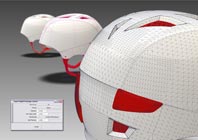
Al Dean looks at Autodesk’s 2010 offerings from its manufacturing solutions division






